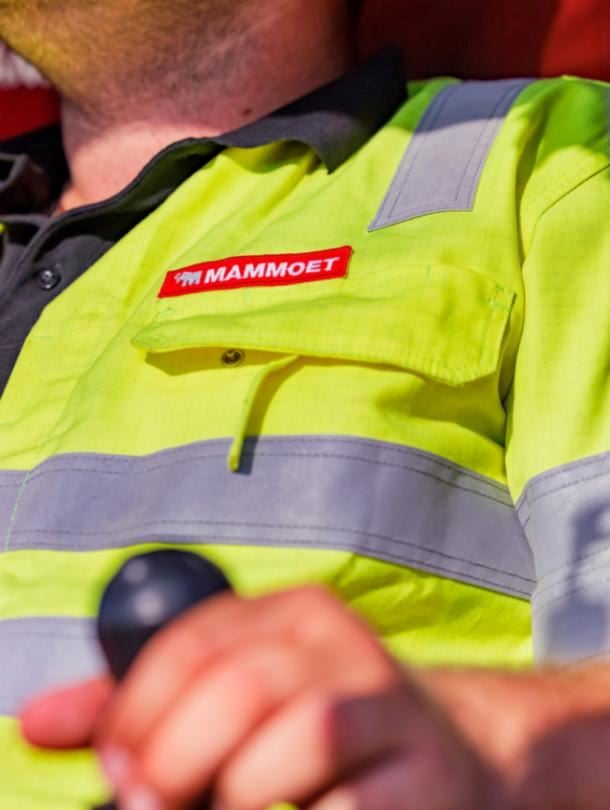Developed by Dubai Holding, Ain Dubai sits on Bluewaters in the heart of Dubai and once operational, it will provide residents and visitors extensive views of the iconic city of Dubai and its shoreline.
In 2014 Hyundai Engineering & Construction (HDEC), the main contractor on the project awarded Mammoet the heavy lifting contract to install the key structural elements of the wheel. Being involved in the early phase of the project enabled Mammoet to present an installation method that delivered greater efficiency, safety, and cost-effectiveness.
They proposed installing the largest elements, the legs, and spindle, directly from the barge they arrived on onto foundations with two of their super heavy lift cranes. This eliminated the need for temporary storage, multiple barge transports and working at extreme heights.
“Having been involved in the construction of many of the UAE’s iconic landmarks, such as Burj Al Arab and its expansion, Dubai Metro, Dubai Mall, and the luxury Five hotel on Palm Jumeirah island, we are pleased to add another one to our successes in the Middle East. Working on Ain Dubai alongside our valuable client HDEC is an honor and a privilege. Engineering capabilities, operational excellence, and the remarkable cooperation of the entire project team ensured that the project was delivered successfully and incident-free,” said Michel Bunnik, Commercial Director, Mammoet Middle East, and Africa.
“I have no doubt that Ain Dubai will earn its place among the world's most famous landmarks, setting a new precedent in the tourism industry and making Dubai a 'first-choice destination for the international leisure and business traveler. We are committed to supporting Dubai’s ambitions to strengthen its position as a global city and business hub of the Middle East,” he added.
Mammoet’s scope:
Lifting the legs and spindle
In 2016 Mammoet successfully positioned Ain Dubai’s four legs onto their foundations and lifted the spindle. Working closely with their client in the planning phase, Mammoet proposed the safest and most efficient method would be to install each component in one piece. Therefore, the legs and the spindle were prefabricated offsite by others before being transported by barge to the installation site. This delivered multiple time-saving and safety benefits. It reduced the number of barge trips required and each component was built safely at ground level before being lifted into place, eliminating the risks of working at heights.
Each 890t leg measured 126m long and 6.5m in diameter. They were rolled onto Mammoet’s barge using 40 axle lines of SPMT at the fabrication yard in Abu-Dhabi. Once on the barge, the legs were securely floated to the site. For the installation, Mammoet paired the world’s biggest crane – PTC200-DS – a 5000t ring crane, with a 3000t crawler crane. Together they ensured the stability and flexibility required to lift each leg and the spindle from the barge into position, whilst working 137m above the ground. Subsequently, Mammoet set a world record by lifting the 1,805t spindle to sit on top of the four legs: it was the heaviest and highest tandem lift ever undertaken worldwide.
Lifting the wheel rim sections
Following the positioning of the legs and the spindle, Mammoet lifted eight rim pieces and temporary spokes. The 3000t crawler crane was the only crane capable of carrying out these lifts. Its high capacity combined with its long lift radius could meet the distance between the barge and the installation point and lift each 700t section in one motion, without the need to set them down or reconfigure the crane.
Removal of temporary braces and spokes
Over a period of three and a half months, Mammoet supported the removal of the temporary spokes until all eight temporary spokes were disconnected from the wheel. Each 112m long spoke, weighing 470t, was skillfully lifted off the structure in tandem by Mammoet’s 600t and 400t crawler cranes.
Key Facts
-
Ain Dubai is the world’s tallest and largest observation wheel, with a height of over 250m. The London Eye is 135m.
-
35m deep piles are under each of the 4 legs
-
Ain Dubai features 48 luxurious passenger cabins
-
Each rotation of the wheel takes approximately 38 minutes
-
Over 10 key countries globally have been involved in making Ain Dubai happen
-
UAE, South Korea & Germany produced the majority of the Steel Wheel Structure
-
UK & Netherlands providing key engineering and project management expertise
-
France has provided the key engineering on the cabins
Hub and spindle
-
The hubs with an internal diameter of 6.25m are made of 200mm thick very high-grade steel, skilfully rolled, welded, and machined to extreme tolerances of circularity.
-
The hubs and spindle assembly is approximately 40m long and 20m high and weighs a massive 1,805t - equivalent to four A380 aircrafts.
-
Each leg of the wheel stands at a height of 126m and is long enough to fit 15 London buses
The rim
-
Each rim section weighs roughly the same as two Airbus A380 aircrafts and was craned onto five temporary supports with two 115m temporary rigid spokes before connection to the hub
-
The wheel rim sections are connected to the hub and spindle by a total of 192 heavy-duty cables, pre-tensioned with up to 300t of force. These cables support the combined 7,500t weight of the rim and its cabins
-
The structure includes around 11,200t of steel, around 33 percent more than the amount of iron used to construct the iconic Eiffel Tower in Paris.
-
Each of the permanent spoke cables responsible for maintaining the structural integrity of the wheel rim is longer than a professional football pitch and comprises 107 separate 9mm thick wires which if they were put together, end-on-end, would span 2,400km – the same distance from Dubai to Cairo, as the crow flies.








